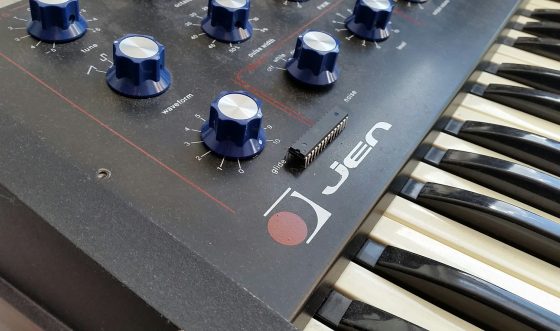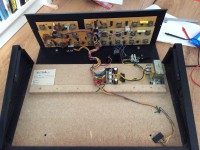.

An Italian beauty, fallen on hard times – starting her career as a budget singer, forced out of business, living in a basement for more than a dozen years, come to my house by sheer accident – and brought to new life and strength by a geek’s love.
The JEN SX-1000 Synthetone is a charming little late-1970s monosynth. Its simplicity is its strength, as you can see in the schematic (in Technicolor on JEN modder Cykong‘s site here and here): a single-VCO, single-LFO, single-filter, dual-envelope, all-analog machine – although there is a digital frequency divider involved, the infamous and increasingly rare SGS-M110 [PDF data sheet here]. Its dials do literally go to 11. Oh, and you can use it to measure when analog became cool again.
This JEN was already in bad shape when its former owner died, and it was stored away in a friend’s basement sometime around the turn of the millenium.
I fell in love instantly with this little machine for a couple of reasons. First, it sounds great, especially the PWM sounds are really a treat. Second, it has all the appeals of retro technology, especially the immediacy of analog dials for manipulating sound. Third, its simplicity has attracted modders. There are quite a few possible additions, modifications and enhancements that stay true to the original character and design of the synth while widening its musical range and power.
This page is meant as a walk-through for the first steps. The ones where you do not find a link have not been completed yet and are, ahem, in development.
- Reviving Jenny: A first look inside confirms a diagnosis of severely corroded key contact. Desoldering the contact springs, reducing the silver oxide to silver with an old housekeeper’s trick for cleaning silverware, and cleaning pots and switches make the machine come back to life.
- Securing Power: Replacing the fixed rear-side mains cable with an IEC socket.
- Troubleshooting: Replace some potentiometers, as they are 40 years old, unencapsulated types – i.e.: have been gathering lots of dust – and were of rather mediocre quality anyway. Especially replacing the Glide pot may fix the frequent “stuck note” problem, but you will find a chart of all potentiometer values here as well.
- Bleaching the yellowed keys. If you must. Don’t expect wonders. They were obviously pretty yellow to begin with.
- Reinforcing the foundations: A sub-oscillator, some additional resistors to adapt noise levels, and removing a capacitor for more bass in the sound.
- Adding Tremolo and variable Filter Tracking control. (Courtesy of Stéphane Grognet in France.)
- More troubleshooting: Adjusting the trim pots, especially to enable self-oscillating resonance; adding capping diodes to keep self-resonance within levels
- Legato: Add circuitry to disable the re-triggering of the envelopes by the M110 chip
- On second thought, let’s not add Legato. Let’s do that together with the midification: Add an Arduino/Teensy microcontroller to replace the M110 keyboard scan/frequency divider. (And gain MIDI control on the way!)
- Add a pre-filter overdrive circuit based on a 4049 CMOS logic chip.
- And an internal phaser, just because I can. And because it sounds great.
- Two envelope hacks: Implement a switch to modulate PWM via ENV1 rather than via LFO, and an AD loop switch to turn ENV1 into a second modulation LFO.
Resources for JEN SX-1000 modding:
- Neil Johnson is the alpha geek of JEN enhancement. His page is THE go-to place – it is terribly difficult to deep-link though. In case you are dropped at the front page: Select “Electronic music”, “gear”, “JEN SX-1000”.
- Kev Atherthon, another Brit, has prepared a PDF document to walk you through his mods – as his modding is earned against his duties as a father and his (so he claims) limited grasp of electronics, you are getting maximum efficiency here.
- He also maintains a very nice little Facebook group for JEN enthusiasts.
- Synth guru Gordon Reid’s Ode to an Underappreciated Synth
